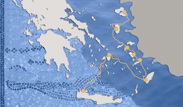The island
Leros is one of the islands
in the Dodecanese, at the eastern edge of the Aegean. Archaeological evidence has revealed the active
presence of humans there since prehistoric times, in finds dating to the late
Neolithic and Early Bronze Age. In historical times the evolution and character
of Leros were heavily influenced by its close relations with Miletus, whose people settled the island. It
later came under Spartan and then Roman rule, while archaeology has also
confirmed the presence of Macedonians. The official religious shrine in the
classical era was at Partheni, in the northern part of the island. This was
associated with the worship of a maiden called Iocallis, who connects the
island with the myth of the Meleagrids and is considered synonymous with the goddess
Artemis. Architectural remains from antiquity include two major fortifications
at Partheni and Xirokambos, as well as the island’s principal settlement at Agia
Marina.
The
transition to
the Christian era found Leros being administered as part of the Province of the
Islands (Provincia Insularum), under the
command of Asia Minor. The spread of
Christianity throughout the Dodecanese did not
exempt Leros, if at some delay, since the cult of Artemis remained strong for a
considerable time. After the new religion prevailed the island was organized
into a diocese. The Diocese of Leros formed part of the Metropolis of Rhodes,
and was definitely founded before 553, when Bishop John I of Leros took part in
the Fifth Ecumenical Council of Constantinople convened by Justinian to condemn
heretical writings.
to condemn
heretical writings.
The early Christian period was
marked by intense building activity. Factors such as the dominance of
Christianity and the organization of living areas favoured the construction of
numerous basilicas
was
marked by intense building activity. Factors such as the dominance of
Christianity and the organization of living areas favoured the construction of
numerous basilicas and the establishment of many new settlements, at Agia
Marina, Partheni, Alinda and Lakki. The archaeological record from this period is
not merely limited to abundant architectural remains, which testify to
extensive rebuilding on the island, but also includes artefacts (coins,
pottery), numerous mosaic
and the establishment of many new settlements, at Agia
Marina, Partheni, Alinda and Lakki. The archaeological record from this period is
not merely limited to abundant architectural remains, which testify to
extensive rebuilding on the island, but also includes artefacts (coins,
pottery), numerous mosaic fragments, votive inscriptions and scattered
architectural members.
fragments, votive inscriptions and scattered
architectural members.
The era of prosperity experienced by the islands in the first Christian
centuries was violently interrupted by the invasion and advance of Arabs in the
Aegean. The years that followed up until the
10th century were ones of decline and stagnation. Sea routes became dangerous,
commercial activity grounded to a halt and many settlements and trading posts were
laid waste. On Leros this turbulent period was reflected in the abandonment of
many villages, as the population moved into the island’s interior. Both Lepida Castle
and Panteli Castle, the most important medieval
monument on Leros, have construction phases dating to this period.
This dark era came to an
end when Emperor Nicephorus Phocas recaptured Crete
in 961, ushering in a period of renewed Byzantine power in the Aegean Sea. Large monasteries were erected on the islands
and communications were re-established with the major centres in the empire.
Imperial documents from the 11th century testify to developments on Leros. Typical
of these was the chrysobull issued by Emperor Alexius Comnenus
issued by Emperor Alexius Comnenus in 1087, granting
the island of Leipsoi, the suburbs of Partheni and Temenion and part of Panteli
Castle on Leros to Christodoulos Latrenus, founder of the Monastery of Agios Ioannis Theologos on Patmos – the following year he was granted the whole castle,
on the order of Anne Dalassene. In 1309 the island of Leros
was occupied by the Knights Hospitaller and incorporated into the region of Kos, together with the neighbouring islands of Kalymnos
and Nisyros. From the late 15th to the early 16th century
the knights carried out repairs to the walls and built an external wall around Panteli Castle, in order to update the island’s
defences following the introduction of gunpowder weapons. Systematic pirate raids
and looting in the second half of the 15th century led to Leros falling to the
Ottomans in 1522.
in 1087, granting
the island of Leipsoi, the suburbs of Partheni and Temenion and part of Panteli
Castle on Leros to Christodoulos Latrenus, founder of the Monastery of Agios Ioannis Theologos on Patmos – the following year he was granted the whole castle,
on the order of Anne Dalassene. In 1309 the island of Leros
was occupied by the Knights Hospitaller and incorporated into the region of Kos, together with the neighbouring islands of Kalymnos
and Nisyros. From the late 15th to the early 16th century
the knights carried out repairs to the walls and built an external wall around Panteli Castle, in order to update the island’s
defences following the introduction of gunpowder weapons. Systematic pirate raids
and looting in the second half of the 15th century led to Leros falling to the
Ottomans in 1522.
Bibliography (4)▼
Comments (0)▼
New Comment▼










